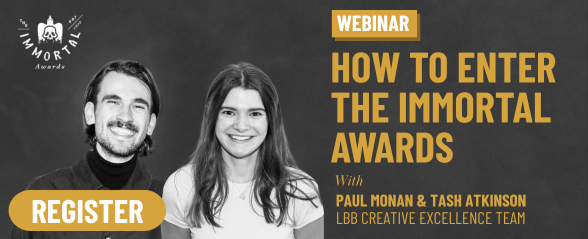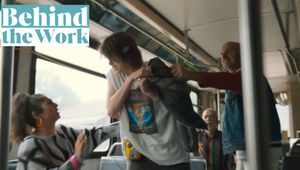
House of Fun: Inside the In-House Creative Flow

The in-house scene has exploded, bringing a new dynamic to the relationship between marketing, creative, media and production - unlocking a host of new challenges and opportunities. Each in-house agency set up is as unique as the brand it’s serving. Many thought it was a trend the industry would outlive, but has it become a true evolution of marketing practice thanks to huge advancements in technology, a new remote workforce, and a need to blend creative thinking with commerce? We sit down with leaders of in-house and external agencies to discuss the difference in culture, creativity and growth of these models in 2023 and beyond.
The speakers on this panel, hosted by LBB’s Alex Reeves, included David Lee, chief creative officer, Squarespace; Jo Shoesmith, global chief creative officer, Amazon; Lou Arbetter, VP, creative and production, PepsiCo Beverages North America; Tom Evans, head of The Kitchen North America, Kraft Heinz; and Vida Cornelious, VP, creative, New York Times.
Kicking off the discussion, the panel explored the reasons why in-house agencies have become so abundant over the last decade. For starters, Tom believes that the increased popularity is a result of content requirements changing as brands seek to create content that is “faster, cheaper and more personalised.” However, all the panellists agreed that the potential financial benefits were no longer the main driving force. “It’s not about being a sausage factory; building a team that can work cheaper and faster to spit out work,” said Jo. “That was the perception, but now our teams are creating Super Bowl ads. The bar is very high, the craft is high, and it’s very competitive with what agencies are doing.”
Jo put forward that it was the creatives - now taking less traditional career paths more than ever - who joined in-house agencies that have lifted the standards and thus increased the desire and demonstrable success of such set-ups. Lou defined these in-house talents as “champions of creative,” explaining that their work spreads the power of what they can do, both increasing growth for their companies and the positive reputation of in-house creative capabilities. David agreed, saying, “It’s not a cost-cutting measure for us - yes there are efficiencies - but the reason we do it is because we love it. We love crafting the work, we know the business inside-out, and we want to do the best creative work possible.”
Each of the brands represented at the panel have moulded their in-house agencies to suit their unique needs and DNA. Shaped by the publishing world the New York Times exists within, for instance, Vida said that T-Brand’s mantra is to bridge the gap between cultural moments and advertising messages. The studio is comprised of editorial talent, as well as creatives, journalists and more - a set up that is different in nature, by necessity, compared to the other panellists’ in-house agencies.
Lou’s creative work at PepsiCo, for example, is centred around “egoless collaboration,” a setup that allows for multiple brands, external PR teams and other agencies to work shoulder-to-shoulder on projects. According to Jo, Amazon also adopts a similar method, as she described the “hybrid approach” that allows them to work on campaigns alone as well as with external partners.
Tom went further to say that The Kitchen was set up to not compete with traditional creative agencies at all, instead focusing “on the things only an in-house agency could.” He continued, “We work as a proactive, always-on agency and write our own playbooks and briefs so we can deploy content at will. We wished to be the embodiment of our brand within culture and social - and we evolved onto bigger things after that.”
Most of the panellists’ companies collaborate with outside agencies on specific projects, but they all lie on a different part of this spectrum. At one end, you have the likes of T-Brand and Amazon - of which Jo said they “rely on great agency partners to keep them honest.” At the other end exists Squarespace, which - thanks to its DIY product - fits comfortably with a more DIY approach to its creative capabilities. “It’a company born with creativity, design and craft at its heart,” said David. “It would be weird to outsource that to an external agency.”
Now creating work from Super Bowl ads to email newsblasts, Squarespace also has begun to produce is own work, hiring creative directors who can also work behind the camera on set and consulting its “rolodex of people to parachute in” if a certain specialism is required on a project-by-project basis.
While the website creation company likes to keep things in-house, David added that this method isn’t for everyone, and pushed back on the notion that in-house agencies would lead to the redundancy of traditional agency structures. “The reason why external agencies will always exist is because you can always point the finger at someone else… If you build an in-house agency, you’re ultimately responsible - you have no one else to blame.”
For Lou, the key to good collaboration is developing empathy among your creatives, saying how PepsiCo rotates its brand marketers throughout the brand studio to experience both the client and agency-side problems and processes. Promoting this clarity between those two worlds - and between internal and external agencies - is also a top priority for Tom and The Kitchen, who said that the goal is to service the brands regardless of where the creative comes from, and that the audience “don’t care” about that distinction. “If you do it well,” he added, “it builds trust and you get to a wonderful position where you can celebrate each other’s success.”
So in-house agencies, in all these different shapes and sizes, now feel like an established part of the creative landscape - but where does it go from here? For Tom and Jo, it’s further integration - “connecting the dots” between all aspects of a client and its potential many brands.
And with everything moving faster, added Lou, the onus is on in-house agencies to “elevate and innovate creative” to move at the speed of culture and technological evolution.
“Creativity is the only job left,” agreed David. “Logic and data analysis… machines will do a better job, and I think that’s OK. I would argue that imagination is really hard to replicate and the creativity, ideas and emotional intelligence of humans is innate… I think there will only be creative jobs, in every field.”















